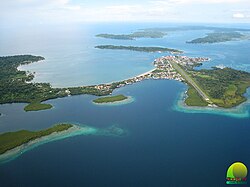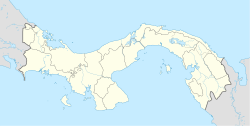Bocas del Toro (Spanish pronunciation: [ˈbokas ðel ˈtoɾo]; meaning "Mouths of the Bull") is a province of Panama. Its area is 4,643.9 square kilometers, comprising the mainland and nine main islands.[5] The province consists of the Bocas del Toro Archipelago, Bahía Almirante (Almirante Bay), Chiriquí Lagoon, and adjacent mainland. The capital is the city of Bocas del Toro (or Bocas Town) on Isla Colón (Colón Island). Other major cities or towns include Almirante and Changuinola. The province has a population of 159,228 as of 2023.[6][7]
Bocas del Toro Province
Provincia de Bocas del Toro | |
|---|---|
 | |
 Location of Bocas del Toro in Panama | |
| Coordinates (Seat of Government): 9°20′26″N 82°14′26″W / 9.34056°N 82.24056°W | |
| Country | |
| Founded | 1903 |
| Capital | Bocas del Toro |
| Area | |
• Total | 4,657.2 km2 (1,798.2 sq mi) |
| Population (2023 census) | |
• Total | 159,228 |
| • Density | 34/km2 (89/sq mi) |
| Census | |
| GDP (PPP, constant 2015 values) | |
| • Year | 2023 |
| • Total | $2.7 billion[1] |
| • Per capita | $15,700 |
| Time zone | UTC-5 (Eastern Time) |
| ISO 3166 code | PA-1 |
| HDI (2017) | 0.719[2] high |
| Website | bocasdeltoro |
| Google Earth,[3] Statiods[4] | |
Christopher Columbus and his crew first visited the area in 1502.[8] Bocas del Toro borders the Caribbean Sea to the north, Limón Province of Costa Rica to the west, Chiriquí Province to the south, and Ngöbe-Buglé Comarca to the east. The Río Sixaola forms part of the border with Costa Rica. A newly constructed bridge spans the river between Guabito and Sixaola, Costa Rica. The bridge is a border crossing used by tourists going between destinations in Bocas del Toro and Costa Rica. Walk across the bridge via the pedestrian causeway or register your vehicle in advance to cross between 8am and 6pm (Panamá time, Costa Rica is an hour earlier).
The province contains two national parks, Isla Bastimentos National Marine Park and La Amistad International Park.[9] The Smithsonian Tropical Research Institute operates a research station on Colón Island just northwest of Bocas Town.[10] There are many banana plantations in Bocas del Toro, often called the oro verde, or green gold of Central America.[11]
History
editThis section needs additional citations for verification. (September 2011) |
Christopher Columbus explored the area in 1502 while searching for the passage to the Pacific Ocean. Columbus's original name for the island was Isla del Drago. In colonial times, Bocas del Toro was part of Veraguas. It was originally part of Costa Rica until, in one of many territorial disputes, Colombia took control of it with armed forces. The then government made a reservation called Bocas del Toro in 1834. In 1850, Bocas del Toro became a part of Chiriqui, then was separated from it and became part of Colon. On November 16, 1903, Bocas del Toro was separated from Colon and became its own province. In 1941, Bocas del Toro was divided into two districts, Bocas del Toro and Crimamola. Four years later, it became part of the same division as before. In 1970, Bocas del Toro district became Changuinola, the district of Bastimentos was eliminated, and three new districts were added, making the province what it is today. The districts' areas changed in 1997 when the Ngöbe-Buglé Comarca was created.
The province is the home of the unique Bocas del Toro Creole of English.
Administrative divisions
editBocas del Toro Province is divided into 4 districts and 30 corregimientos.[12] On 8 June 2015 the new Almirante District was created, after splitting out from Changuinola District.[13]
| District | Establishment | Surface area | Corregimientos (Subdivisions)
|
Cabecera (Seat) |
|---|---|---|---|---|
| Almirante District | 2015 | * | Puerto Almirante, Barriada Guaymí, Barrio Francés, Nance de Risco, Valle del Risco, Valle de Aguas Arriba | Puerto Almirante |
| Bocas del Toro District | 1855 | 430 km2 | Bocas del Toro, Bastimentos, Cauchero, Punta Laurel, Tierra Oscura | Bocas del Toro |
| Changuinola District | 1903 | 3,995 km2 | Changuinola, Barriada 4 de Abril, Cochigro, El Empalme, El Silencio, Finca 30, Finca 6, Finca 60, Guabito, La Gloria, Las Delicias, Las Tablas, Teribe | Changuinola |
| Chiriquí Grande District | 1970 | 207 km2 | Chiriquí Grande, Bajo Cedro, Miramar, Punte Peña, Punta Robalo, Rambala | Chiriquí Grande |
* The area of Almirante District is included in the figure quoted for Changuinola District, from which Almirante was divided.
Geography
editClimate
edit| Climate data for Bocas del Toro (1971–2000) | |||||||||||||
|---|---|---|---|---|---|---|---|---|---|---|---|---|---|
| Month | Jan | Feb | Mar | Apr | May | Jun | Jul | Aug | Sep | Oct | Nov | Dec | Year |
| Mean daily maximum °C (°F) | 30.8 (87.4) |
30.7 (87.3) |
31.0 (87.8) |
31.4 (88.5) |
31.9 (89.4) |
32.0 (89.6) |
31.5 (88.7) |
31.8 (89.2) |
31.9 (89.4) |
31.7 (89.1) |
31.6 (88.9) |
31.0 (87.8) |
31.4 (88.6) |
| Mean daily minimum °C (°F) | 20.4 (68.7) |
20.2 (68.4) |
20.5 (68.9) |
21.4 (70.5) |
22.2 (72.0) |
22.2 (72.0) |
21.7 (71.1) |
21.8 (71.2) |
22.0 (71.6) |
22.0 (71.6) |
21.8 (71.2) |
20.6 (69.1) |
21.4 (70.5) |
| Average precipitation mm (inches) | 123.9 (4.88) |
266.1 (10.48) |
83.8 (3.30) |
369.1 (14.53) |
178.3 (7.02) |
259 (10.2) |
420.1 (16.54) |
440.7 (17.35) |
311.2 (12.25) |
150.5 (5.93) |
291.7 (11.48) |
563.6 (22.19) |
3,458 (136.15) |
| Average precipitation days | 16.6 | 14.6 | 14.8 | 15.2 | 16.7 | 17.9 | 20.9 | 18.4 | 15.8 | 16.4 | 17 | 20.0 | 204.3 |
| Source: World Meteorological Organization [14] | |||||||||||||
Bocas del Toro is a travel destination that is most known for its vibrant culture, beaches, rainforests, and surfing. It is estimated that 95% of the economy in Bocas del Toro is based on tourism.[15] The most popular destinations in Bocas del Toro are the Zapatilla Islands, the Bastimentos National Marine Park, Starfish Beach, Red Frog Beach, Bluff Beach, and Hospital Point.
The High-Season for tourism in Bocas del Toro is from November to April, which also coincides with the dry season as well as the being the best surf season. The best months to visit Bocas del Toro for dry weather are January, February, March, May, September, and October. These are statistically the driest months of the year. However, dry weather is also common in June, August, November, and even the wettest month of the year, December, can see weeks without rain.
Bocas del Toro is not a typical Caribbean tourist destination such as Cancún or the US Virgin Islands.[original research?] It is very much still a 3rd world destination that is embracing development at a typically slow and laid back pace. There are no large hotels lining the beaches or big resorts covering the islands.[citation needed] Instead, there are small, boutique accommodations.
Common activities in Bocas del Toro include Surfing, Scuba Diving, exploring Bat Caves, learning about the local indigenous cultures, Cacao Farm tours, hiking, and nightlife.
Bocas del Toro is becoming famous globally for the abundance of newly constructed and affordable overwater bungalow hotels. Over the next decade, it is predicted to be a competing location to the Maldives and Tahiti for overwater bungalows.
Protected areas
editThe national parks in the province are Isla Bastimentos National Marine Park (Parque Nacional Marino Isla Bastimentos), which contains most of Isla Bastimentos and some smaller nearby islands and extends into the large nature preserve at the Red Frog Beach Island Resort,[16] and La Amistad International Park (Parque Internacional La Amistad), which spans the Costa Rica–Panama border.[9] Bocas del Toro contains most of the Panamanian section of the park, which covers 400,000 hectares (4,000 km2; 1,544 sq mi). The Costa Rican section of the park covers 584,592 hectares (5,846 km2; 2,257 sq mi).[17] La Amistad International Park is a designated UNESCO World Heritage site.[17]
Gallery
editReferences
edit- ^ "TelluBase—Panama Fact Sheet (Tellusant Public Service Series)" (PDF). Tellusant. Retrieved 2024-01-11.
- ^ "Sub-national HDI – Area Database – Global Data Lab". hdi.globaldatalab.org. Retrieved 2018-09-13.
- ^ Google Earth
- ^ Provinces of Panama
- ^ Somos Panama Archived March 15, 2010, at the Wayback Machine Retrieved: 15 March 2011
- ^ "Bocas del Toro (Province, Panama) - Population Statistics, Charts, Map and Location". www.citypopulation.de. Retrieved 2024-03-10.
- ^ Panama 2010 Census Archived 2017-09-13 at the Wayback Machine Retrieved: 24 May 2011
- ^ "Lonely Planet". Bocas del Toro History. Retrieved: 15 March 2011
- ^ a b Frommer's Panama (1st ed.). 2007. ISBN 978-0-470-04890-0.
- ^ Bocas del Toro Research Station Retrieved: 14 June 2009.
- ^ "Changuinola". Changuinola Banana. Archived from the original on 2011-07-08. Retrieved: 15 March 2011
- ^ "Municipios (Distritos) de Bocas del Toro". Editorial OX. Retrieved 15 November 2012.
- ^ "Ley 8 de junio de 2015" (PDF). Gaceta Oficial. Retrieved 22 June 2015.
- ^ "World Weather Information Service – Bocas del Toro". World Meteorological Organization. Retrieved 25 July 2010.
- ^ "Bocas del Toro Visitors Guide". Retrieved 19 May 2021.
- ^ "Red Frog Beach". Red Frog Beach.
- ^ a b UNESCO La Amistad International Park overview Retrieved: 14 June 2009.
10. www.bocasdeltoro.com Official Web Site of the Island 11. ^ http://bocasdeltoro.travel/ Official Bocas del Toro Travel Website
External links
edit- Paraiso for Sale 2011 documentary about US immigration to Bocas, and the attendant impact on locals and indigenous peoples

